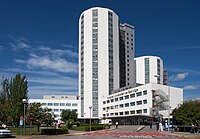
Photo from wikipedia
Importance Physician management companies (PMCs), often backed by private equity (PE), are increasingly providing staffing and management services to health care facilities, yet little is known of their influence on… Click to show full abstract
Importance Physician management companies (PMCs), often backed by private equity (PE), are increasingly providing staffing and management services to health care facilities, yet little is known of their influence on prices. Objective To study changes in prices paid to practitioners (anesthesiologists and certified registered nurse anesthetists) before and after an outpatient facility contracted with a PMC. Design, Setting, and Participants This retrospective cohort study used difference-in-differences methods to compare price changes before and after a facility contracted with a PMC with facilities that did not and to compare differences between PMCs with and without PE investment. Commercial claims data (2012-2017) from 3 large national insurers in the Health Care Cost Institute database were combined with a novel data set of PMC facility contracts to identify prices paid to anesthesia practitioners in hospital outpatient departments and ambulatory surgery centers. The cohort included 2992 facilities that never contracted with a PMC and 672 facilities that contracted with a PMC between 2012 and 2017, collectively representing 2 255 933 anesthesia claims. Exposures Temporal variation in facility-level exposure to PMC contracts for anesthesia services. Main Outcomes and Measures Main outcomes were (1) allowed amounts and the unit price (allowed amounts standardized per unit of service) paid to anesthesia practitioners; and (2) the probability that a practitioner was out of network. Results From before to after the PMC contract period, allowed amounts increased by 16.5% (+$116.39; 95% CI, $76.11 to $156.67; P < .001), and the unit price increased by 18.7% (+$18.79; 95% CI, $12.73 to $24.84; P < .001) in PMC facilities relative to non-PMC facilities. Results did not show evidence that anesthesia practitioners were moved out of network (+2.25; 95% CI, -2.56 to 7.06; P < .36). In subsample analyses, PMCs without PE investment increased allowed amounts by 12.9% (+$89.88; 95% CI, $42.07 to $137.69; P < .001), while PE-backed PMCs (representing half of the PMCs in the sample) increased allowed amounts by 26.0% ($187.06; 95% CI, $133.59 to $240.52; P < .001). Similar price increases were observed for unit prices. Conclusions and Relevance In this cohort study, prices paid to anesthesia practitioners increased after hospital outpatient departments and ambulatory surgery centers contracted with a PMC and were substantially higher if the PMC received PE investment. This research provides insights into the role of corporate ownership in health care relevant to policy makers, payers, practitioners, and patients.
Journal Title: JAMA internal medicine
Year Published: 2022
Link to full text (if available)
Share on Social Media: Sign Up to like & get
recommendations!